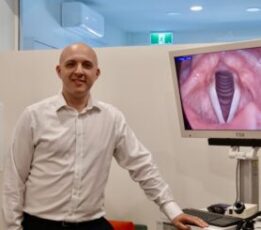Muscle Tension Dysphonia
Dysphonia refers to an abnormal voice, and can include difficulties with pitch, loudness, quality, and flexibilityofthevoice. Muscle Tension Dysphonia(MTD) is a descriptive term for inefficiency in the way someone produces voice. This typically results from excess laryngeal and extra-laryngeal muscle activity, that iswhen the muscles around the larynx are tight or tense. Tension in the muscles of the larynx and neck can prevent smooth and easy voice production.
Causes
MTD commonly occurs in females,particularly young and middle-aged women. The causes and contributory factors appear to be multifactorial but can include high vocal load, repeated voice misuse, stress and reflux.
- Primary MTD refers to dysphonia in the absence of concurrent organic vocal fold pathology and is associated with inefficient posturing of the laryngeal muscles during voicing without obvious psychogenic or neurological causes and in the absence of concurrent vocal fold pathology.
- Secondary MTD alternatively refers to a dysphonia in the presence of an underlying lesion or organic condition.
Signs and Symptoms
Individuals with MTD may experience some of the following symptoms:
- A feeling of ‘tightness’ in the neck
- A sensation of a lump in the throat
- Pain in the frontal neck region and upper chest
- Upper chest and shoulder tension
- Lack of control over breathing, leading to reduced vocal support
Individuals with MTD may have a voice quality with some or all these characteristics:
- Breathy
- Strained
- Hoarse
- High pitched
- Strained and strangled
Treatment
Treatment for MTD aims to reduce the muscular tension in and surrounding the larynx, and to promote healthy and efficient voice production forthe future. This is achievedthrough:
- Voice therapy with a Speech Pathologist, who will help youto use your voice efficiently with lessmuscle tension and effort. The speech pathologist will also assist you to implement voice care strategies at work, socially and in your leisure activities.
- Reducingstresslevelsor other potentially contributory factors
- Occasionally injecting botox into select laryngeal muscles can help to ‘break’ the muscle tension cycle, and also differentiate significant muscle tension dysphonia from neurological disorders of the larynx –your MVAC team will advise.







